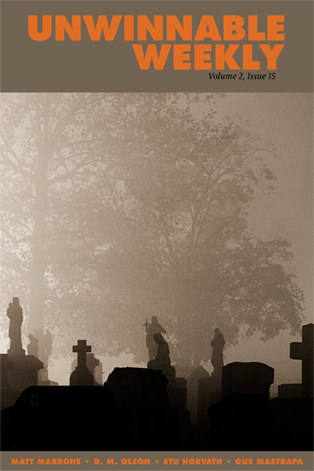
A Collection of Apocalypses: An Interview with Paul Tremblay
The following is a reprint from Unwinnable Weekly Issue Sixty Seven. If you enjoy what you read, please consider purchasing the issue or subscribing.
———
She was dead the entire time! He was married to his own mother! She’s actually her brother!
You know how twists work. They’re satisfying. That may be all right for other genres, but not for horror. No matter how terrifying that surprise may be, it still makes us feel good on some level.
Horror writer Paul Tremblay preys on the desire for satisfaction, our need for a story to entertain. He withholds gratification and sends us on our way, bereft, thirsty, stomach growling. The result is a quiet kind of horror, ambiguous and paranoid, that lingers on long after the last page is turned.
“SWIM Wants to Know if It’s as Bad as SWIM Thinks,” for example, is the story of a meth-addicted mother who kidnaps her daughter from a foster home during an attack by giant sea monsters. The monsters themselves are never explained. We never even get a clear look at them. There’s no pay off in this respect. Even as the monsters stomp around, Godzilla-like, just off screen, all we can do is measure the wreckage of SWIM’s life. The dread just hangs there, enduring. With nowhere for it to go, no release, it hollows you out.
“Some of that, honestly, is my own internal battle with realism,” says Tremblay. “A girl can’t be really possessed, right? There’s no such thing as giant sea monsters, yeah? So keeping the question of is-this-really-a-supernatural-event-or-something-else alive satisfies that annoying ‘but-Paul’ voice in my head. Working with that initial unsureness helps put the reader on unsure footing, too. The real horror of that story (I hope) is what has happened to SWIM, what her life has become and what she’s going to do.”
Like the monsters from the depths, we don’t see what SWIM is going to do, with her daughter, with the monsters outside, with the gun she stole. The story ends before she makes her final decision. Another cruel withholding.
We’re left to wonder, and it haunts us.
Tremblay was born in Beverly, Massachusetts, about 30 minutes north of Boston. His mother was a bank teller and his father worked in the Parker Brothers toy factory in Salem, where Tremblay also worked in the summers of his youth. He was quiet, short, skinny and a sports geek (“I obsessively played the baseball version of Dungeons & Dragons, Strat-o-Matic. It involved cards and dice and charts and stuff. Good times.”).
 Despite constant exposure to Parker Brothers’ Ouija boards, Tremblay didn’t come to horror until much later. A self-described scaredy-cat as a kid, he was afraid of the dark and wouldn’t go into the basement alone.
Despite constant exposure to Parker Brothers’ Ouija boards, Tremblay didn’t come to horror until much later. A self-described scaredy-cat as a kid, he was afraid of the dark and wouldn’t go into the basement alone.
“For years I slept with a fortress of stuffed animals arranged around my head,” he says, “but I’d still watch a show called Creature Double Feature on Saturday afternoons. The program usually featured Godzilla flicks, Hammer movies or black and white classics. I loved the Godzilla movies and the other ones usually scared the hell out of me.
“The ending to Quatermass and the Pit is imprinted in my brain, as is the monster in the basement in The Brain that Wouldn’t Die. I remember just seeing commercials for Alien, Trilogy of Terror, and Wolfen and being terrified. Oh, and the commercial for ‘Salem’s Lot, that got me too. I saw Jaws when I was 11, and it gave me a decade’s worth of shark nightmares. Poor Quint.”
It was only as a University of Vermont grad student that horror clicked for Tremblay. A gift from his wife Lisa – The Stand, by Stephen King – set him on his way. He had soon read every King book he could get his hands on, then proceeded to work his way through Peter Straub, Joyce Carol Oates, Clive Barker, Shirley Jackson, Kurt Vonnegut and more. Despite graduating with a degree in mathematics, he found himself focusing on writing.
“I really wanted to be in a punk band too,” he says, “but I have no real musical talent, so writing was kind of my second choice. Don’t tell anyone.”
All this history can be seen in Tremblay’s work, both in what and how he writes. His prose is lean (like Jackson) and conversational (like Vonnegut), often offsetting meticulous plots (like Straub) and experimental narratives (like Oates) with workaday details (like King) and an undercurrent of surprising humor (like both Jackson and Vonnegut, again). He is, in many ways, a synthesis of those writers who inspired him in his grad school days and the movies that terrified him as a child.
“Everything I watch and read sticks with me and serves as inspiration,” says Tremblay. “I love the idea that my books and stories are in a dialogue with the stories within the genre that came before it.”
It is perhaps because of his childhood fears that Tremblay is able to write children with such authenticity. A Head Full of Ghosts, “The Two-Headed Girl,” “We Will Never Live in the Castle” and “It’s Against the Law to Feed the Ducks” all feature youthful protagonists of varying ages of immaturity.
The latter is perhaps the prime example. The story of a family on rural vacation during the end of the world, it is told largely from the point of view of Danny, the couple’s five-year-old son. Because of Danny’s young age, his parents shield him from the televised details of the situation and he can’t comprehend those he witnesses first hand. This leaves the reader with only the vaguest notion that something is terribly wrong, the same way you could feel your dad was angry or your mom was upset as a kid.
Here, the horror is that Danny remains a four-year-old in the face of that terrible future. He explores, chases ducks, plays silly word games with his mom and displays all the simple joy that you’d expect of a kid on vacation at a lake house. The horror comes from knowing that joy will inevitably be ripped away.
“As goofy it sounds, I still feel very much like a kid. Or at least an imposter in an adult’s body,” says Tremblay. “While memories of specific childhood incidents drift away with the passing years, what hasn’t drifted away are the emotions I felt and thought processes I had; feeling the wonder, the confusion, the fear, the seeming eternity of time (which was a horror; that time was not moving and would not move fast enough for the child-me when I wasn’t feeling particularly happy with myself), the bone-deep loneliness of the teen years and the unbridled joy of curiosity, too.
“It helps that I’ve always been either a student or a teacher, so I remain fixed on a child’s yearly clock. And, of course, my own kids are big influences and inspirations. I watch them closely. I can see so many of the same emotions and thoughts I had as a kid mixing in with their very own, unknown-to-me feelings. Their childhood and challenges are so different than mine were. Better or worse, I have no idea, but clearly different.
“I watch myself closely too. My triumphs and failures as a parent make it into everything. I had it pointed out to me a few years ago that so many of my stories were about children, childhood or parenthood. I hadn’t realized it, though it seems kind of obvious now. Many of these stories reflect my own anxieties, fear, and hopes of being a parent, and of someone who is still a son, one who vividly remembers what it was like to be a really young son.”
Horror must tell us something special at this particular moment in history. On television, in movie theaters and in the printed word, the genre is experiencing more popularity than it has in decades. Perhaps more importantly, horror currently boasts a variety that has never been broader, deeper or more diverse. If it can be said that horror is in the middle of golden age, the critical response to A Head Full of Ghosts certainly puts Tremblay right in the center of it.
“Horror is a thing I do, or watch, or read, to the point where I have a hard time understanding how or why other people aren’t into it and actively avoid it. When horror is done well, I love the sense of awe, of holy-shit-what-is-that, and its honesty; not being afraid to show the best and worst of us and the universe.
“Art and literature reveals some sort of truth, or confronts it, and then asks what are you going to do now? How are you going to live through this? How do any of us live through this? The best horror stories really dig at those questions and address them in a way that’s unique. When I write horror stories, those questions are always ringing in my head. I want to know what my characters are going to do once that terrible truth has been revealed.
“I want to know what I would do, too.”
Back to SWIM the meth head, she of the kidnapping and the giant sea monsters. Her name is derived from the abbreviation for Someone Who Isn’t Me, a grim inside joke used on an internet forum she frequents. That it is dedicated to the best practices of meth abuse and its existence doesn’t seem at all implausible is another kind of horror Tremblay delights in.
“The fear of technology run amok is as old as speculative fiction and there’s certainly lots of fertile ground for horror to work within current technological trends,” says Tremblay.
Another tale, “The Blog at the End of the World,” derives its chills as much from its awful commenters as it does its chronicling of an extinction-level epidemic.
“While I still offer condolences for the loss of your friend, I’m not surprised that you’re experiencing headaches and the like. You’re so obsessed with the textbook symptoms, you’re now psychosomatically experiencing them,” says one troll with surprisingly good grammar in the story. “I am surprised it has taken this long. I had February 2009 in the pool. Get help. Psychiatric help.”
“I tend to use technology more as a setting, as how we communicate, as this-is-what-we-live-with-now,” says Tremblay. “With ‘Swim’ I wasn’t going for a large statement about tech. The message board is just a place she goes as she has no other friends, so these anonymous messages from strangers act like a Greek chorus.
“I wrote ‘The Blog at the End of the World’ for an online market, so I wanted it to look like an actual blog and set it up to be so. When the story was first published, we made sure the links worked, you could click around and read in any order you wanted. The story was about our inundation with information and misinformation, how we communicate with each other online, how online reading changes how we read and process that information. Ultimately, it is about the fear of what online information you could and couldn’t trust.”
The end of the world, whether by sea monster or epidemic or less obvious means, is another theme that runs deep in Tremblay’s work, particularly in his collection In the Mean Time.
“My witnessing the end of civilization (or more personally, the end of my family, loved ones, and friends) is the fear that I graduated into,” he says. “Back when I was a kid, I was worried about monsters and ghosts and whatnot, but then sometime in the 1980’s I became aware of the Cold War and nuclear annihilation quickly shot to the top of my fears list. And it hasn’t ever really left me. Of course there’s an odd, narcissistic appeal to end-of-world scenario’s too when we think yeah it’s me, I’d definitely be the last person left, bravely carrying on.
“It kind of goes back to what I’d said early about wanting to know what the characters will do after the truth is revealed. In fiction anyway, I’m less interested in the how of the end, but what happens next, what happens in the afters. Also, end of the world fears are such a part of the zeitgeist (they always are, always have been), more times than not the reader can come up with their own version of the end that will be more terrifying and more personal than what I would’ve thrown out there.”
Tremblay’s 2015 novel, A Head Full of Ghosts is about a fourteen-year-old girl named Marjorie, who may be possessed by a demon. Or presenting early symptoms of schizophrenia. Or something else entirely may be going on – regardless, the strain on her family is intense. It is a masterful novel, perhaps the best the genre has seen this year, and seems to be a kind of culmination, trying together all the ticks and themes of Tremblay’s earlier work.
For instance, the story is from the point of view of Marjorie’s eight-year-old sister, Merry.
There’s a blog, chronicling the history and tropes of the exorcism sub-genre.
There’s a reality TV crew shooting a multipart documentary on Marjorie and the effect her condition has on the rest of the family.
There’s even an apocalypse, in a metaphorical sense. The unemployed father – and by extension, the whole family – is positioned as a kind of endangered species barely surviving in a world that has irrevocably changed.
And the ending, as described by the unreliable narrator, is deeply disturbing because of all the questions it leaves not just unanswered, but unanswerable.
“In one sense, A Head Full of Ghosts is my love letter to horror with all the winks and nods to my favorite (and not-so-favorite) books and movies,” says Tremblay. “It is clearly responding to Blatty’s and Friedkin’s The Exorcist. I’m a pop culture junky, so I welcome it seeping into my work as long as it serves a purpose and informs the story.
“Hopefully my stories put some new spin on the references, or make you think about it in a different way. A part of A Head Full of Ghosts is, hopefully, an exploration of why we cling to obscure pop cultural reference points; why some of us find meaning or identity in how well we know a band, a book, a horror movie.”
Perhaps there’s something more, though.
After all, the father was put out of work when a merger with Hasbro forced his toy factory to close – a fictional analogue to the closure of Parker Brothers’ Salem plant in 1991.
The mother is a bank teller.
And Merry has many, many stuffed animals.
It is hard to not wonder how much more of Tremblay’s history lurks in the details of A Head Full of Ghosts. Or how much of his stories lurk in his history. Perhaps there’s a twist ending here after all.
If there is, though, you can be sure Tremblay won’t let us off that easy.
———
Author’s Note
Paul Tremblay has two collections, Compositions for the Young and Old and In the Mean Time. He has written three novels, A Head Full of Ghosts, The Little Sleep and No Sleep till Wonderland, the latter two being detective novels following the cases of a narcoleptic private investigator. Additionally, “SWIM Wants to Know if it’s as Bad as SWIM Thinks” is available in Year’s Best Weird Fiction, Vol. 1.
He is currently at work on a new novel, Disappearance at Devil’s Rock, due out in June of 2016.
In addition to writing, Tremblay is also on the board of directors for the Shirley Jackson Awards.
* * *
This is the third installment in an occasional series that examines the creators behind the new strain of literary horror. This was spurred on by my recent discovery of this rich new vein of writing and my dismay that no one I talk to seems to know much about it. Every book store I visit, I check for work by the likes of Simon Strantzas, Nathan Ballingrud, Kaaron Warren and more. Every time, I leave disappointed. This is my small attempt at spreading the word.
The first interview was with Laird Barron, in Unwinnable Weekly Issue One.
The second interview was with John Langan, in Unwinnable Weekly Issue Forty-Three.
The third interview was with Stephen Graham Jones, in Unwinnable Weekly Issue Fifty-Eight.
At Paul Tremblay’s suggestion, Livia Llewllyn (Engines of Desire: Tales of Love and Other Horrors) will be the next victim…
———
Stu Horvath is the editor in chief of Unwinnable. He reads a lot, drinks whiskey and spends his free time calling up demons. Sometimes, he plays with toys and calls it “photography.” Follow him on Twitter @StuHorvath.




